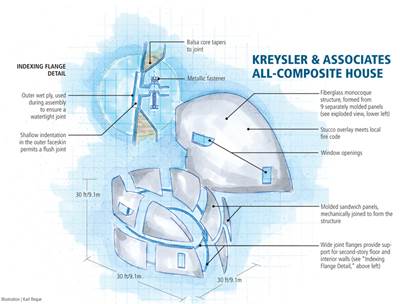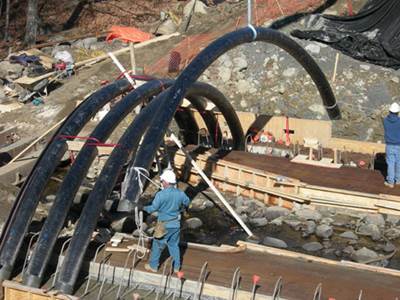Composites 2010 Product Showcase
The ACMA’s Las Vegas exhibition reflected an industry in recovery.
Cautious optimism was the byword in booth after booth at the American Composites Manufacturers Assn.’s (ACMA) Composites 2010 tradeshow (Feb. 9-11, Las Vegas, Nev.). This big improvement over the subdued mood during ACMA’s 2009 outing in Tampa, Fla., was reflected in the 2010 show statistics: 3,000 attendees (including exhibitors and press) — 18 percent greater than in 2009 — and 180 exhibiting companies.
The exhibition’s keynote event was kicked off by industry analyst Ray MacNeil (Ray MacNeil Composites Consulting, Sewickley, Pa.), who echoed the cautious optimism but confirmed that 2009 was one of the worst economic years in U.S. history. The gross domestic product (GDP) dropped 2.45 percent — the largest decrease in 63 years — while the composites market contracted a whopping 28 percent in 2009. That said, he contended that the composites industry has good reason to look forward with optimism, based on its history: Since 1960, the industry has suffered six downturns, but overall, its growth has far outperformed the U.S. GDP (gross domestic product) and the steel and aluminum industries. Far from a “mature” industry, composites also have plenty of room to grow. MacNeil’s forecasts for 2010, 2011 and 2012, respectively, U.S. GDP growth of 2.6, 2.8 and 3.8 percent. In the composites industry, for 2010-2015, he says to look for a 7 percent CAGR (compound annual growth rate). Clouding the picture, however, is the possibility of a jobless recovery, MacNeil warned, adding that if unemployed people who are no longer actively looking for work were included in national unemployment reports, that figure would be closer to 16 percent.
Keynote speaker Mitt Romney anchored the event’s opening day in a session sponsored by AOC LLC (Collierville, Tenn.). In a wide-ranging address, the former Massachusetts governor and 2008 Republican presidential primary candidate touched on hot-button issues — healthcare and education reform, the need for a national energy strategy, and the subject of international relations. But his economic message was aimed at business owners, who he encouraged to focus on innovation and involvement in the political process, contending that small- and mid-sized businesses are the key to the U.S.’s ongoing success.
ACMA Conference highlights
ACMA’s conference offerings included 90 educational sessions and technical papers presented by 110 speakers. Notable among them was a panel discussion of emerging markets for composites. Chaired by ACMA’s Composites Growth Initiative director John Busel, the panel included Dr. Habib Dagher of the University of Maine’s AEWC Advanced Structures and Composites Center (UMaine, Orono, Maine); Jonathan Trovillion, from the U.S. Army Corps of Engineers; and Matt Garran of the American Wind Energy Assn. (Washington, D.C.). Key comments included Dagher’s observation that the industry should not focus on how to replace concrete and steel, but instead seek ways that composites could work in concert with these traditional materials, creating a win/win situation. (A good example of Dagher’s philosophy in action is the hybrid composite/concrete beam that took a top prize in this year’s ACE awards competition (see the "Awards for Composites Excellence" section, below). Dagher also stressed that offshore wind energy is a key emerging market for composites. But Garran cautioned attendees that while the wind market has huge growth potential, it can take a blade manufacturer up to five years to enter the market with a viable product — composite part reliability is, from his perspective, a huge issue and much improvement is possible. Trovillion cited corrosion as a huge problem for the U.S. Department of Defense (DoD), noting that it costs upwards of $10 billion (USD) per year to address the problem in the DoD’s metal vehicles and other equipment. He also discussed work that his department is doing on multifunctional composites as a key market for the future. The panelists agreed that standards and codes for composites are a key concern, and that world (rather than regional or local) standards are probably a necessity.
The panel was followed by a presentation by Michael Masserman, the director of the office of Advisory Committees for the U.S. Commerce Dept.’s International Trade Admin. Noting that U.S. exports as a share of GDP are the lowest of any of the major countries in the world, he revealed that less than 1 percent of U.S. companies are involved in exporting, according to his statistics, and of that small group, 58 percent export to only one country. A government-wide export strategy, the National Export Initiative, is now in place to help small businesses increase their offshore market share, Masserman reported. He urged attendees to take advantage of Initiative funding and loans to increase their export activities.
Among the technical presentations, those that addressed renewable energy applications were at the forefront throughout the program, with composites in wind blades and other turbine parts a hot topic. As one example, UMaine’s Dagher, for example, discussed his group’s initiative to develop offshore wind resources in Maine, using new technology that includes floating tower foundations for deep water and higher-durability blades and materials. The DeepC Wind Consortium, with 30 or more partners, recently won a major U.S. Department of Energy (DoE) grant, and will introduce a turbine unit next year for testing, says Dagher. Additionally, Kevin Lambrych, global wind energy technology leader at Ashland Performance materials (Dublin, Ohio), presented feasibility data, regarding the use of epoxy vinyl esters in wind blade applications, with particular focus on Ashland’s Derakane resin. According to Lambrych, when the resin is optimized for blade fabrication, it has proved suitable for use in heated tools, curing in about 24 hours, compared to the 36 hours typically required for epoxies. Lambrych’s research also compared dynamic mechanical properties and found that epoxy vinyl ester resins comply with wind energy industry requirements established by Germanischer Lloyd.
On the nanotechnology front, speaker Bor Z. Jang, CEO of Angstron Materials Inc. (Dayton, Ohio), raised a few eyebrows with his technical paper presentation of the nano graphene platelets (NGPs) his company recently developed. Constructed as “flattened carbon nanotubes,” NGPS, according to Jang, feature mechanical and electrical properties that rival carbon nanotubes (CNTs) and do so more cost-effectively. He reported the following data for his NGPs: Young’s modulus, 1,000 GPa; intrinsic strength, 130 GPa; thermal conductivity, 5,300 W/mK; in-plane thermal conductivity, 20,000 S/cm; and a surface area-to-weight of 2,675 m²/g (28,793 ft²/g). Reportedly, NGPs are easily dispersed in resins and their surfaces are easily functionalized. NGP loadings in a resin system, Jang claims, could reach 75 percent if necessary, without the agglomeration or viscosity issues typically encountered with CNTs at much smaller ratios. Jang noted that his company has done two studies of NGP use. In one, 1 percent loading of NGPs (by weight) in a PMMA resin increased the Young’s modulus by 80 percent. In another study, a 0.1 percent load in an epoxy increased the epoxy’s tensile strength 50 to 80 percent and substantially increased its resistance to crack propagation. Angstron has production capacity of 30 metric tonnes (almost 66,140 lb) per annum. In the next few months, Jang says, his company will introduce an NGP-modified epoxy resin matrix for composites applications. Jang identified good applications for his NGPs: fuel cells, carbon/carbon brakes, lightning strike protection and EMI/RFI shielding.
Several representatives of Alcan Baltek (Northvale, N.J.) presented papers. Dr. Kurt Feichtinger attracted a lot of attention for his presentation of a unique composite bridge deck, for which he and co-authors Russ Elkin and Edison Ospina received ACMA’s Best Paper Award in the “Infrastructure and Corrosion” category (see "Balsa-cored nanotechnology bridge deck installed" under “Editor’s Picks,” at right). Elkin, the company’s well-known processing expert, also presented a paper on how best to select and install resin feed lines for infusion processing. He was on hand for many of the closed molding demos conducted by Composites One (see Composites One item below and the photo and caption at right).
ACE and Pinnacle Awards program
ACMA’s 2010 Awards for Composites Excellence (ACE) Awards competition were conferred on an array of innovative entries. UMaine’s AEWC was selected for the “Most Creative Application” for its Bridge-in-a-Backpack, a hybrid composite/concrete bridge combining the advantages of advanced composite materials and concrete (see "Bridge cost cut with inflatable arches," under "Editor's Picks"). The “Infinite Possibility” award, which demonstrates the potential to significantly increase the use of composites in existing or developing markets, was presented to Harbor Technologies Inc. (Brunswick, Maine), for its Hybrid Composite Beam (HCB), a new structural member that comprises a composite shell, concrete compression reinforcement, and a tension reinforcement, i.e., steel or carbon fiber members (see, for example, “Hybrid composite beams ....” under “Editor’s Picks”). Composites Solutions Pty. Ltd. (Queensland, Australia) won the “Process Innovation” award for its one-way flap valve, fabricated using MIR technology (see the MIRteq Pty. Ltd. item, below). The ACE award for “Superior Quality (in an Open Molded Part)” was presented to Alaglas Pools (St. Matthews, S.C.), for a swimming pool made with a resin system that is 28 percent derived from biologically renewable resources and/or recycled materials. The “Technical Innovation for Corrosion Application” categry was topped by Ershigs Inc. (Bellingham, Wash.). The company’s FRP Pilot Carbon Capture – Scrubber & Ductwork project at AEP Mountaineer Station (see "Composites selected for new carbon capture system," under "Editor's Picks"). Part of an effort to capture and store carbon dioxide (CO2) from an existing coal-fired power plant, the AEP carbon capture system required over 200,000 lb (90.7 metric tonnes) of composites and 9,400 man/hours to complete. The “Innovation in Green Composites Technology” honors went to Bedford Reinforced Plastics (Bedford, Pa.) for its BRP Green Wall, a double-walled hybrid composite panel made with recycled resin, flax fiber and E-glass, and intended to replace a conventional construction-industry drywall system. Finally, the “Best of Show” award was presented to Kreysler & Associates Inc. (American Canyon, Calif.) for its California Bay House, a two-story residence designed as a monocoque structure consisting of nine prefabricated, fire-retardant FRP panels (see “Residential construction breakthrough: Composites find a home,” under “Editor’s Picks”).
In a separate competition, the Pinnacle Awards program, organized by the International Cast Polymer Alliance (now part of ACMA), Monroe Industries (Avon, N.Y.) received the “Best of Show” award and top honors in the “Best Installation Award – Residential” category for its Robal Glass tabletop, which features recycled glass cast within a bio-based resin. The table was made from Envirez bio-based resin (see Ashland Performace Materials item, below). The “Best Installation Award – Commercial/Specialty” was awarded to International Marble Industries Inc. (Woodstock, Ga.) for its ISIS Luxury Bath.
Innovation in the aisles
On the show floor, CT staffers spied a number of new product developments. The following is a sampling, in alpha order, from the many on display in Las Vegas.
Filament winding innovator Acrolab Ltd. (Windsor, Ontario, Canada) exhibited its super-thermal-conductive mandrel technology for induction heating and curing of filament wound parts without the need for an oven. The company’s chief technical officer Joseph Ouellette presented a technical paper discussing the underlying research and the testing performed during development of the induction-heating technology.
AOC Resins (Collierville, Tenn.) premiered its the EcoTek line of styrene-free unsaturated polyesters and vinyl ester resin systems, featuring as much as 30 percent bio-content and up to 45 percent recyclable content. The renewable content comes from corn, plant oils and other sustainable resources that are precursors to the building blocks of the polymeric backbone. The recycled content comes from reclaimed polyethylene terephthalate (PET). Applications include open and closed molding, casting and cured-in-place polymers. EcoTek H460-EKAG (28 percent bio-content) was used by Alaglas Swimming Pools (Matthews, S.C.) to manufacture the composite swimming pool that won the “Open Molded Part” award in the ACMA’s ACE Awards Competition.
The emphasis at the Ashland LLC (Dublin, Ohio) exhibit was on composites in building construction. On display was a house laden with composite materials in the walls, roof trusses, doors and more (see photo and caption at right). Supporting this theme, the company announced major expansions of its Envirez unsaturated polyester resin line, formulations that contain renewable materials (~20 percent from soy derivatives). Envirez LF 60380, for tub and shower applications, provides the home improvement market a new green option. Envirez 7241 T-15 is a prepromoted thixotropic corrosion-resistant isophthalic polyester for hand layup/sprayup of fume hoods, ducts, tanks and pipes. Also new: The Enguard DSZ series of formulated gel coats, based on Envirez resin technology (13 percent renewable content) represents the first use of Envirez technology in a gel coat. All of these materials can earn credits from the U.S. Green Building Council’s Leadership in Energy and Environmental Design (LEED) program. Ashland president Ted Harris was on hand and echoed the cautious optimism on the show floor, noting that Ashland expects moderate sales growth in 2010, with China and South America leading the way.
Bayer MaterialScience LLC (Pittsburgh, Pa.) came to the show with a collection of parts and structures that make innovative use of the company’s Baydur polyurethane. At center stage was a 40L pressure vessel manufactured by Profile Composites (Sidney, B.C., Canada) using Baydur polyurethane and braided carbon fiber from A&P Technology Inc. (Cincinnati, Ohio). The tank was an award winner at last year’s JEC Composites Show in Paris and is produced in 20-minute cycles, using specialized resin transfer molding (RTM) equipment developed by MAG Industrial Automation Systems (Hebron, Ky.). Profile president Geoff Wood was in the Bayer booth and said the company is under U.S. Department of Transportation funding for the tank’s development and currently is in the license/standards phase. This, he expects, will be completed within two years, but indicated that commercialization would come earlier. Wood says the MAG RTM cell developed for the tanks’ manufacture is highly automated, repeatable, consistent and requires very little manual intervention. One cell, he reports, will produce about 10,000 tanks annually. Larger tanks are under development, ranging from 60L to 160L.
Also in the Bayer booth was a knotter shield for a baler, made via long fiber injection (LFI), sporting a Class A surface out of the mold. The part was molded by Romeo RIM Inc. (Romeo, Mich.), using Baydur STR 675 polyurethane. Pultruded polyurethane (Baydur PUL 2500) was used by Conforce International Inc. (Concord, Ontario, Canada) to make EKO FLOR ms1, ribbed panels 1.25 inches/31.75 mm thick, 24 inches/610 mm wide and cut to length to provide flooring for ocean-going containers. The panels, which are driven on by trucks during container loading and unloading, were expected to withstand 8,000 lb/3,629 kg of load per truck wheel, but exceeded 17,000 lb/7,711 kg. (This is one of several polyurethane pultrusion applications discussed this issue in “Polyurethane composites: Bearing bigger loads,” under Editor’s Picks”).
Finally, Bayer emphasized its internal research and testing program that intends to determine the viability of polyurethane composites reinforced with Baytubes carbon nanotubes for potential use in 1.5+ MW wind turbine blades. The project is funded, in part, by a $750,000 grant from the DoE. Bayer subcontractors Case Western Reserve University (Cleveland, Ohio) and Molded Fiber Glass Companies (Ashtabula, Ohio) will provide research assistance. Bayer’s polyurethane-based systems, reinforced with carbon nanotubes during the resin phase, have been proven to create as much as a 50 percent increase in strength-to-weight ratio by modifying the resin component of the composite at levels ranging from 0.1 percent to 0.4 percent.
Bedford Reinforced Plastics (Bedford, Pa.) won the ACE award for “Innovation in Green Composites Technology” for its BRP Green Wall, a wall prototype made of 25 percent flax-fiber fabric, 25 percent E-glass rovings and 50 percent recycled resin. The wall consumes 40 percent less “embodied energy” than one made from glass fiber-reinforced polymer. The company also presented a technical paper on the use of natural fibers in pultruded products, which discussed, in part, the effects that chemical treatments of the fibers have on the final product’s performance, compared to that of glass fiber-reinforced pultrusions.
BYK USA (Wallingford, Conn.) showcased its multifunctional additives for a wide variety of applications. BYK-W 997 and BYK-W 9011 are recent introductions that improve wetting and dispersion in filled unsaturated polyester and epoxy resin systems. They also reduce system viscosity, allowing a higher filler load. The company’s closed mold market manager Tom Delay presented a technical paper on the use of additives in low-shrink sheet molding compound and bulk molding compound, in which they improve fiber wetting and reduce part scrap in closed mold processing.
CMS North America Inc. (Caledonia, Mich.) revealed that its CNC machining equipment was employed by the BMW Oracle Racing team in the cutting of components for the winning America’s Cup trimaran racing yacht. One of many yacht-racing groups to which the company has supplied equipment, BMW Oracle employed a CMS Ares 5-axis machine with an automatic axis-realignment and tool-measuring device.
Visitors to Composites One (Arlington Hts., Ill.) “Lean, Mean, Closed Molding Machine” glass-walled demonstration area (see photo and caption, at right) could watch resin transfer molding (RTM), Light RTM and vacuum infusion methods in action, with commentary from industry experts. The educational exhibit was sponsored by the Closed Mold Alliance, which also includes RTM North Ltd. (Vonastra, Ontario, Canada) and FormaShape (Kelowna, British Columbia, Canada), and featured equipment from Magnum Venus Products (MVP, Clearwater, Fla.). The demo showcased the proprietary MIR (micro-fiber infused resin) process from startup MIRteq Pty. Ltd. (Cardiff, New South Wales, Australia). For more in the MIR process, see the MIRteq Pty. Ltd. item below.)
Eastman Machine Co. (Buffalo, N.Y.) highlighted its latest generation laser cutting system for reinforcement fabrics. The dual-configuration laser comes equipped with a three-tool cutting head, a market “first,” says the company, which reduces changeover time between cutting methods. The traditional cutting head can be equipped with any combination of rotary and straight knife blades, notches or punches, and the tool head includes a pneumatic pen/marker for labeling.
Although an entirely bio-based resin that performs as well as a petroleum-based counterpart, thus far, has eluded formulators, EcoPoxy Systems (Johnston, R.I.) believes it has found it in its core product. A clear epoxy derived entirely from soybean oil, the product cures at 50°C to 95°C (122°F to 203°F) and reportedly can be used in RTM, pultrusion and prepreg processes. Flexural strength is 14,434 psi; flexural modulus is 0.4398 Mpsi, compressive strength is 11,409 psi; compressive modulus is 0.3639 Mpsi; tensile strength is 9,692 psi; and tensile modulus is 0.3934 Mpsi.
Flow International Corp. (Kent, Wash.) touted recent orders for $11 million worth of abrasive waterjet and routing machine tool systems for composites, which will be delivered within the next 12 to 18 months. Most of the orders were received from supplier partners of Toulouse, France-based Airbus, which are gearing up to work on multiple Airbus aircraft programs. The company also presented a technical paper about integrated 5-axis gantry and 6-axis articulated arm robots fitted with waterjet equipment for more efficient production.
Huber Engineered Materials(Fairmount, Ga.) said its MoldX non-halogenated, alumina trihydrate flame retardant for sheet molding compound (SMC) applications, introduced at this show last year, is making good strides in the composites market. Notably, company officials report that because the product meets strict UL 723 codes for smoke toxicity/density, it is being considered as a steel replacement in applications that until now have been out of reach for composites. One application, in particular, is for SMC use in an air conditioning structures.
Imperium Inc. (Beltsville, Md.) talked with CT about pilot testing of its handheld I600 Acousticam ultrasonic imaging device in partnership with The Boeing Co. (Chicago, Ill.). As part of the program, technicians scan parts at a remote site while experts at a Boeing facility view (wirelessly via WebEx software) and interpret the data in real time. Ten of the units already have been shipped to Boeing, targeted initially at inspection of fuselage areas around cargo doors. Other clients include Bell Helicopter Textron (Ft. Worth, Texas), the U.S. Navy and the U.S. Air Force.
Jushi Group Ltd. (Zhejiang, China) and its U.S. distributor Gibson Fiberglass (Irwindale, Calif.) announced at a press conference an environmental stewardship program, which includes several improvements and modifications to its glass manufacturing process to save energy and resources. For example, waste heat from the glass furnaces is recovered for use in drying the glass product, and process water and steam condensate is captured, treated and recycled. Jushi also reuses its waste fiberglass in the production of its E6 Enhanced glass fiber.
LCOA Composites (Lake Forest, Calif.) came to the show with its line of ballistic-resistant laminates for defense structure applications, such as guard shacks, safe rooms, toll booths and shelters. Of note in this line was a several-inches-thick laminate, made from E-glass infused with a bio-resin derived entirely from cashew nuts. Rob Wassem, VP business development, said the E-glass/cashew nut material is delivered as a prepreg and provides up to Level IV ballistic protection. The prepreg’s areal density is 15 lb/ft.
Automotive parts supplier Magna Exteriors (Grabill, Ind.), ventured outside its normal operating sphere with the introduction of a sheet molding compound (SMC). Trademarked EpicBlendSMC, the material is designed to help reduce weight and cost, consolidate parts, resist corrosion and increase design flexibility. The product is produced in-house, and is available in multiple formulations from the company’s Grabill, Ind., and Saltillo, Mexico, facilities. Magna says it is currently the only SMC compounder in Mexico, and between the two fully automated facilities, the company reportedly has the capability to produce more than 200 million lb (nearly 90,720 metric tonnes) of SMC annually. The SMC already is used for automotive, commercial truck, consumer and industrial market applications. Formulas are available for Class A, structural, sanitary ware, electrical (including UL-approved) applications and can be formulated in flame/smoke resistant, weather-resistant aand/or in-mold colored versions.
Materials Innovation Technologies (Fletcher, N.C.) highlighted its significant expansion into carbon fiber recycling technology, including a new recyclingvfacility in South Carolina that should be operational at CT press time. The company, which has in its portfolio a unique automated chopped-fiber preforming process, called 3-DEP, hinted that it is working on new methods that could employ recycled fibers to create parts and preforms for a variety of end uses.
The “Lean, Mean, Closed Molding Machine” demo (see Composites One item, above) showcased the proprietary MIR (micro-fiber infused resin) process from startup Mirteq Inc. (Cardiff, New South Wales, Australia). MIR is a method for treating glass microfibers to improve fiber/resin bonding and then dispersing those fibers in a polyester or vinyl ester resin. The mixture can be poured, injected, sprayed, cast or infused readily at room temperature, with low-temperature (and therefore, low-cost) molds, at low injection pressure. Nonstructural yet complex parts are possible, such as the flapper valve that captured ACMA’s 2010 ACE award for “Process Innovation.”
Nederman LLC (Westland, Mich.) showcased its technology for collecting and transporting dry or wet materials generated during manufacturing. The company demonstrated both stationary high-vacuum units as well as on-tool extraction and portable units for dust collection during sanding and finishing operations, particularly in the wind-blade manufacturing sector.
Park Electrochemical Corp. (Melville, N.Y.) exhibited its trademarked Nelcote product line of composite prepregs for the industrial markets. Wholly owned subsidiary Park Advanced Composite Materials Inc. (PACM), which manufactures advanced composite materials, has enhanced its prepreg manufacturing capabilities to include materials for wind energy, marine and transportation applications. In addition, PACM reportedly is developing a low-temperature-cure product for industrial applications that require robust mechanical properties, medium toughness and long out-time at room temperature.
Polystrand Inc.’s (Montrose, Colo.) Green Series reinforcing tape is intended to reduce the environmental footprint of thermoplastic composites. Available in unidirectional, bi-ply and tri-ply configurations, the tapes feature recycled polyolefin resin as the matrix. Similar tape reinforcements are already available, featuring a variety of virgin polymers, including polypropylene. Although the “green” tapes’ resin content is recyclate, the company says the physical properties of the tapes approach those of prime material at competitive prices.
SAERTEX USA LLC (Huntersville, N.C.) exhibited its wide range of noncrimp fabrics (NCFs) in both glass and carbon fiber. The company has eight facilities worldwide, producing stitch-bonded textile materials for the composites industry. Its China facility was recently awarded certification under ISO Norm 9001:2008 by Germanischer Lloyd.
First-time exhibitor Smart Tooling, div. of Spintech LLC (Xenia, Ohio), a spinoff from CRG (Cornerstone Research Group Inc.) (Dayton, Ohio), marketed shape memory polymer-based reuseable mandrels. Heated to a transition temperature, the mandrels can be shaped to part dimensions, cooled, then used for part layup and cure. After part cure, the mandrel is reheated to above the transition temperature, causing it to recover its original shape. As a result, it can be extracted from the part. The reusable mandrels are available in two formulations — Smart Mandrels RT are appropriate for low-temperature-cure applications, up to 113°F/45°C, while Smart Mandrels 250 can be used for high-temperature processes up to 250°F/121°C.
Gel coat supplier Sogel Inc. (Longueuil, Quebec, Canada) announced the availability of its one-step metallic gel coats for the North American market. Applied without porosity, using conventional airless equipment, they do not require a clear gel coat to protect the metallic finish in exterior applications. The gel coats’ weather resistance, gloss retention and low color variation reportedly meet or exceed standards for applications in the marine and transportation industries, as well as in other environments where aesthetics and high performance are required.
Scott Lewit, president of Structural Composites Inc. (West Melbourne, Fla.), emphasized Shark Skin, a new elastomeric laminate for marine use that is designed to replace traditional gel coat. This three-layer laminate features a layer of unidirectional carbon fiber fabric between two layers of Innegra high-modulus polypropylene (HMPP) fiber from Innegra Technologies, Simpsonville, S.C.). The result is an ultraflexible but compression-tough laminate that, Lewit says, is being evaluated for use on the U.S. Navy’s Zodiac boats. Early results indicate hull/deck weight reduction of up to 40 percent.
Syrgis Performance Initiators (Helena, Ark.) announced at the show that it has broken ground on a new standalone laboratory facility to support its global organic peroxides business. The new facility, to be located at the company’s manufacturing complex in Helena, is expected to be complete by May. The company produces methyl ethyl ketone peroxides (MEKP) in Helena and in Köpmanholmen, Sweden, and benzoyl peroxide (BPO) in its Helena facility, for initiating composite polymer cure.
TCM Composites (div. of Kenway Corp., Augusta, Maine) showcased its temperature-controlled molding equipment for vacuum infusing parts of any thickness, with the help of resins modified with Arkema Inc. (Philadelphia, Pa.) Luperox IS 300 additive technology. Formulated to promote controlled radical polymerization, the additive also made its debut at the show. Partnered with industry expert Andre Cocquyt (GRPguru, Brunswick, Maine), the company offers the molds, consulting services for process design, and employee training.
Toho Tenax America Inc. (Rockwood, Tenn.) underscored composites for transportation at its exhibit, and reported brisk traffic during the show. The company contended that its carbon fibers offer lighter weight and mass reduction, which translates to lower energy consumption, in automobiles, trains and aircraft. Also at the booth were spun carbon fiber yarns and fiber blends made with carbon and Teijin Aramid yarns. Sister division Diversified Structural Composites (Erlanger, Ky.) was on hand to exhibit pultruded parts using carbon, including some made via a new technology that allows curved sections.
Vectorply Corporation (Phenix City, Ala.), one of the supplier partners involved with Composites One’s closed molding demonstrations, showed its VectorFusion “multiplane” stitchbonded multiaxial reinforcements, designed specifically for vacuum infusion processing. Introduced several years ago, the product architecture sustains fabric loft, ensuring that the laminate will not compress under vacuum pressure, which can choke resin flow. According to the company, the stitchbonded construction provides a smoother finished surface with less print-through compared to other Z-axis type reinforcements.
Zeon Chemicals and Telene (both based in Louisville, Ky.) showcased Telene-brand dicyclopentadiene (DCPD) resin, a two-component thermoset resin that is processed with low-pressure reaction injection molding (RIM) methods and equipment. Highly impact-resistant, the resins are widely used for large, complex parts, such as agricultural equipment body panels, and for anti-corrosion applications where their combination of modulus, toughness and cost-effective processing are appropriate. While often molded as a neat resin, Telene grades are available with fiber reinforcements that offer a 50 percent higher modulus, says the company.
Zyvex Technologies Inc. (Columbus, Ohio) exhibited its Arovex prepreg materials enhanced with carbon nanotubes. After special treatment (what the company calls functionalization) the nanoscale materials are dispersed in epoxy resin systems. These epoxies, used to make prepregs, enhance prepreg performance. Also on display were similarly enhanced Epovex adhesives and resins. The company spotlighted the Piranha, the first unmanned surface vessel (USV) constructed with Arovex materials. The USV is aimed at naval military customers (see “Editor’s Picks,” at right).
Related Content
Materials & Processes: Fibers for composites
The structural properties of composite materials are derived primarily from the fiber reinforcement. Fiber types, their manufacture, their uses and the end-market applications in which they find most use are described.
Read MoreCarbon fiber in pressure vessels for hydrogen
The emerging H2 economy drives tank development for aircraft, ships and gas transport.
Read MoreNovel composite technology replaces welded joints in tubular structures
The Tree Composites TC-joint replaces traditional welding in jacket foundations for offshore wind turbine generator applications, advancing the world’s quest for fast, sustainable energy deployment.
Read MoreForvia brand Faurecia exhibits XL CGH2 tank, cryogenic LH2 storage solution for heavy-duty trucks
Part of its full hydrogen solutions portfolio at IAA Transportation 2022, Faurecia also highlighted sustainable thermoplastic tanks and smart tanks for better safety via structural integrity monitoring.
Read MoreRead Next
Residential construction breakthrough: Composites find a home
Composite materials get the go-ahead for an unconventional but code-compliant California house.
Read MoreBridge cost cut with inflatable arches
Stay-in-place composite formwork shortens installation, doubles service life of concrete bridge structure.
Read MoreFrom the CW Archives: The tale of the thermoplastic cryotank
In 2006, guest columnist Bob Hartunian related the story of his efforts two decades prior, while at McDonnell Douglas, to develop a thermoplastic composite crytank for hydrogen storage. He learned a lot of lessons.
Read More
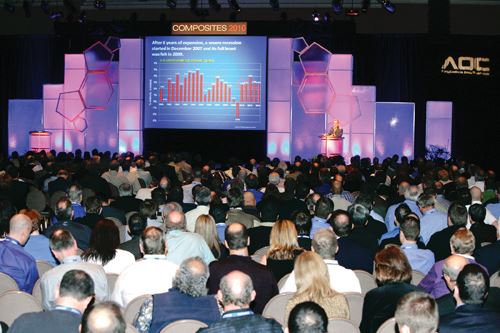
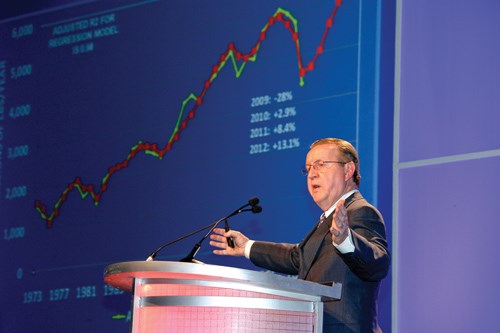
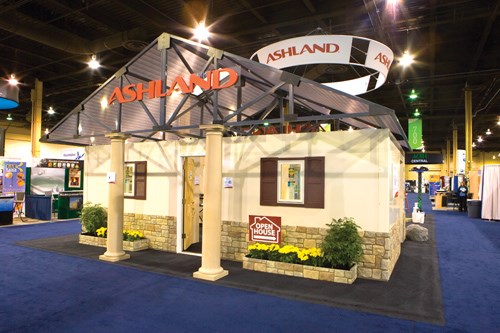
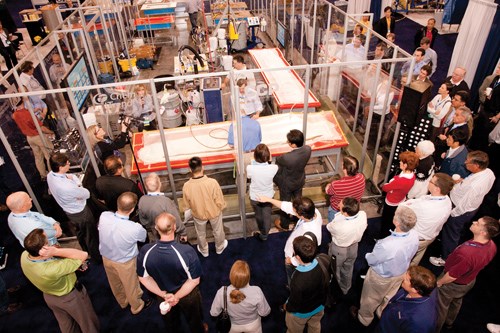
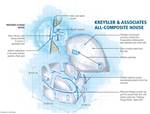



















.jpg;maxWidth=300;quality=90)





